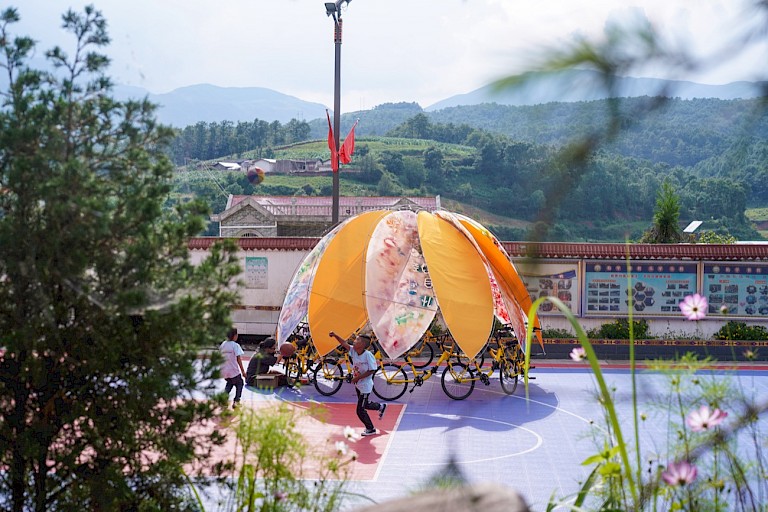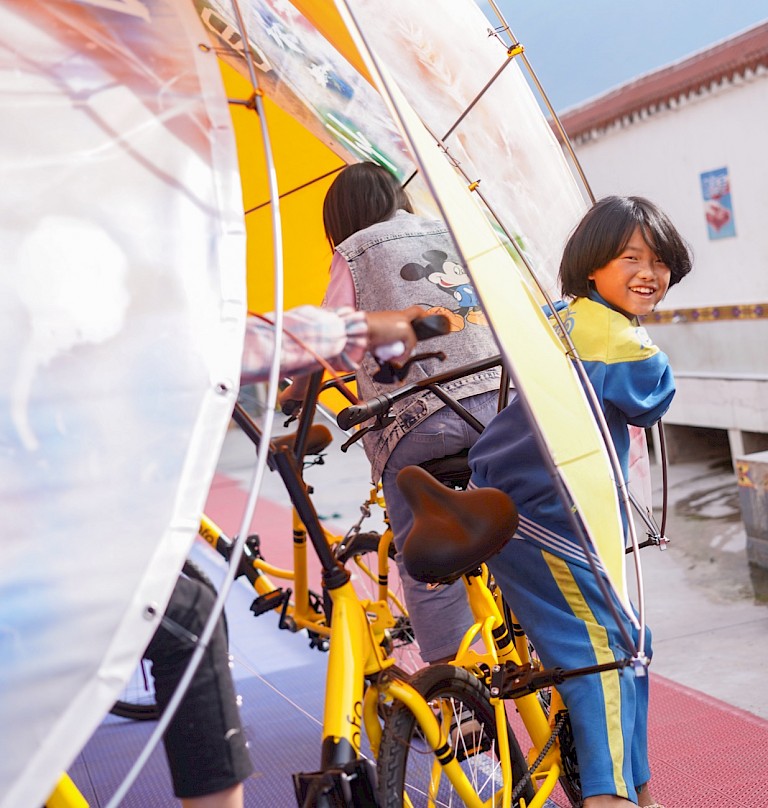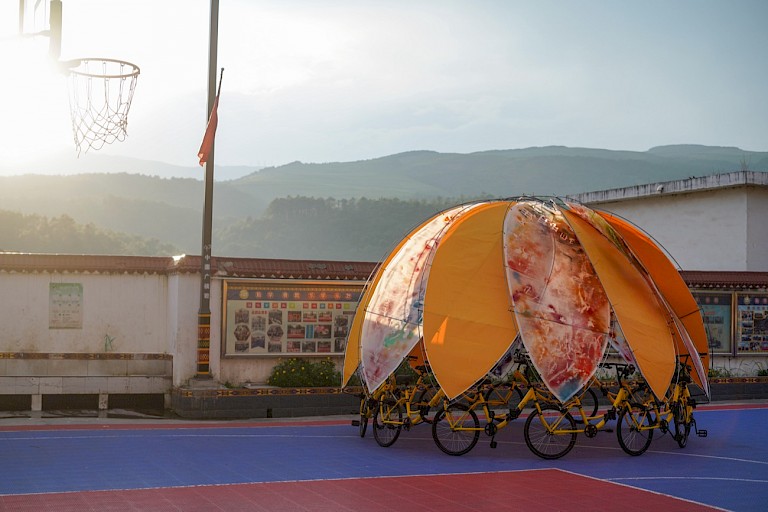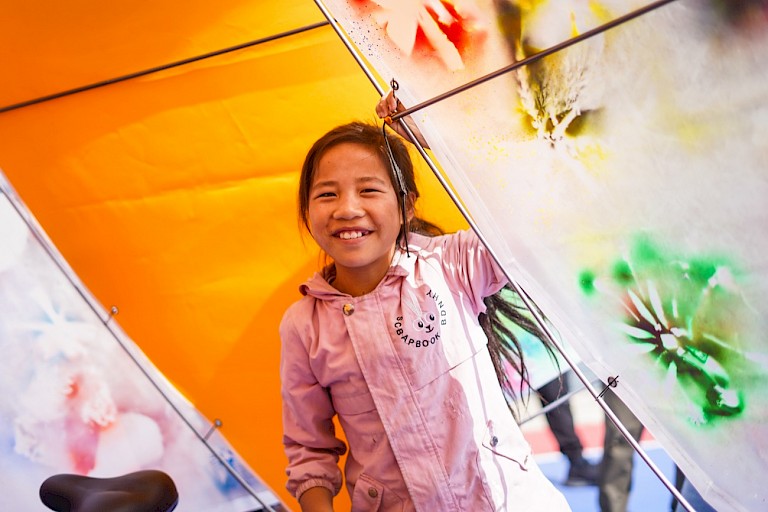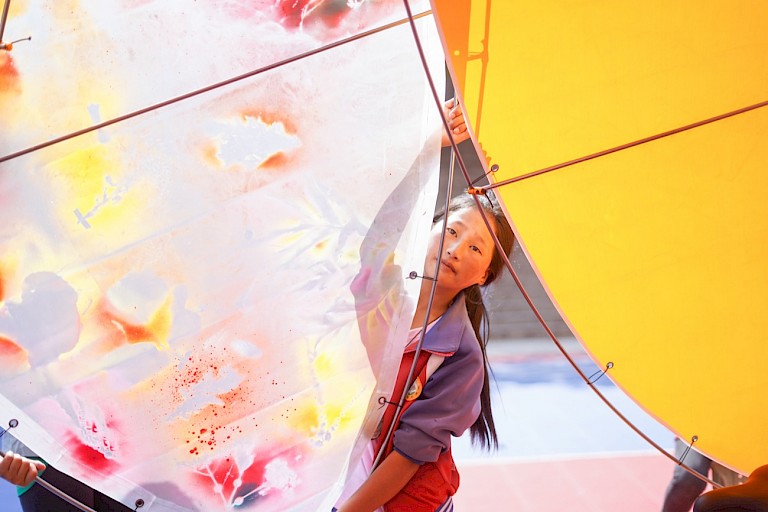



The rapid development of cities contrasts sharply with the predicament of children's education in many small mountain towns. The scarce arable land and meagre farming income here force local people to go out to work to make ends meet. A large number of children are left in the care of elderly grandparents, becoming left-behind children. As a kind of socially engaged art, the Fireworks Plan took the construction of art installations as an entry point, and gradually developed and improved a brand new summer camp art education system for the psychological and educational status of left-behind children, and designed many introductory art education courses suitable for children aged 8-14.
The United Nations has proposed 17 Sustainable Development Goals, calling on the world to take joint action to eliminate poverty, protect the planet, improve the lives and future of all people. The mission of the Fireworks Plan is closely related to goals such as quality education, reduced inequalities, decent work and economic growth.
All materials used in the Fireworks Plan are remade from ready-made items, and Blooming in particular uses a large number of shared bikes abandoned in cities.
As a socially engaged art, from artefact to affair, the Fireworks Plan designs courses, camp settings, experiences, sharing, interactions, and interventions in the reproduction of rural social relations based on local contexts. The Fireworks Plan aims to solve universal problems rather than individual cases, and explores solutions to China's rural education issues in innovative and sustainable ways.
Program SPARK is a public welfare project founded by artist/architect Li Hao in 2017. The mission of Program SPARK is closely related to goals such as quality education, reduced inequalities, decent work and economic growth. In its implementation, it adheres to the following principles:
Environmental Friendliness and Readymade Art: All materials used in Program SPARK are remade from ready-made objects. These so-called ready-mades, mass-produced in factories, already have clear functional attributes. We hope to redefine these objects through an artistic composition and imperceptibly impart the concept of ""transforming objects around you and rediscovering the value of beauty"" to children. Co-creation adds a touch of warmth to materials and structures, perhaps planting more possibilities for children.
Community Building: From artefact to affair, Program SPARK designs courses, settings, experiences, sharing, interactions, and interventions in the reproduction of rural social relations based on local contexts. Community observation, exploration and discovery are incorporated into the curriculum to uncover gems of rural life and protect the precious innocence and ideals of childhood. Children rediscover the relationships between nature and humanity, civilisation and the environment, building self-confidence, cohesion and identity through the revival of ancient wisdom and community covenants.
Design for Social Fairness: Education is the key to escaping poverty and improving socioeconomic status. As a public welfare project initiated by an architectural team, Program SPARK aims to solve universal rather than individual issues, exploring innovative and sustainable solutions to China's rural education challenges.
The construction and curriculum design principles of Program SPARK include:
Materials are recyclable without customisation. For budget, time and environmental considerations, all construction course materials used in Program SPARK are common industrial products available on the market without customisation. Whether it's flexible tubes, wooden ladders, PVC water pipes, steel angles and other structural materials, or spray guns, coloured glassine, translucent PVC, corrugated paper rolls, ropes and other auxiliary materials, they are lightweight, inexpensive and easy to obtain. If relocated for exhibitions, these materials can also be easily dismantled, transported to the destination and reassembled in a short time.
Creativity and Expression: Children Lead Throughout. In Program SPARK courses, children lead the creative process from start to finish. We do not design a rigid course framework that requires children to achieve certain predetermined goals or imitate template works. The final presentation of the construction project is also completed by the children’s own design and setup. This is a work entirely created by the children. In addition, expression is as important as creation. Not only expressing personal preferences, but also making judgments about the value of the work - “I like or dislike it because...” rather than just “I like or dislike it...” That is, trying to explain the reasons behind the judgment. But teachers only guide and ask questions without making judgments or conclusions, encouraging students to respond to the feelings, emotions and ideas conveyed by the visual imagery.
Teaching Outcomes: Avoid Demonstrating Correct Answers. In the initial stages of Program SPARK courses, the outcomes are kept confidential from the children - we try to avoid demonstrating how to organize answers correctly; and arouse their interest in learning through their questions (wonderment). In Program SPARK, unique expressions come from unconstrained problem-solving activities. In these activities, children's creativity is not pre-directed by adult course requirements. By stimulating perception, thinking and emotion, and providing training in using certain necessary communication skills, adult course requirements can play an inspiring role in the art-making setting.
In actual teaching in the Yi Autonomous Prefecture, many children can only listen and speak but not read or write the Yi script. Coupled with the fact that language learning itself can be boring, the Yi script has gradually become marginalised. Blooming transforms the reading and writing of Yi script into a highly interesting art creation experience through public art, stimulating children's interest in learning through positive and creative experiences, thus ""seeding"" appreciation and knowledge to encourage subsequent study and use.
Since its establishment in 2017, Program SPARK has won many international awards: the IF Social Impact Prize (also the only Chinese team to win this award that year), the Sustainability Award for Young Projects from the Beijing Contemporary Art Foundation, the Shenzhen Global Design Award bronze prize, etc. It has also been reported by many international and domestic media such as China Daily, becoming a representative social engaged art project.
Socially engaged art has become a powerful way for artists to address current political and social challenges. Although the practice is often very mild, it is now widely considered to be at the forefront of contemporary artmaking.
Blooming Time - Program SPARK is a typical case combining the concepts, practices and forms of socially engaged art, solving real social problems while possessing an extremely communicative formal aesthetic, and paying tribute to the tradition of ready-made art. The project demonstrates innovation in applying concepts such as ready-mades, public art, and up-cycling in a rural Chinese context, providing a compelling case study of socially engaged art and its ability to address real world issues.
Blooming Time - Program SPARK promotes sustainability and grassroots empowerment through art, pointing towards an engaged, socially-conscious future for the field, as people want to be part of the creative process and audiences for artworks relevant to them. Social participation makes the public a constituent of meaning-making, a collective endeavour that makes art accessible and attractive.
Socially engaged art is an emerging field that brings broader audiences and society closer to artists and their creations. Blooming Time - Program SPARK demonstrates that art can be a powerful tool for social change beyond aesthetics, community-based collaboration and co-creation are impactful models of artmaking, artists have a responsibility to address inequities and ethical issues affecting society, institutions must support socially-conscious practices beyond the market-driven art world, and local specificity and community identity matter, not one-size-fits-all solutions. It reveals how artists can activate social imagination and progress through inclusive, ethical creative action rooted in place.
